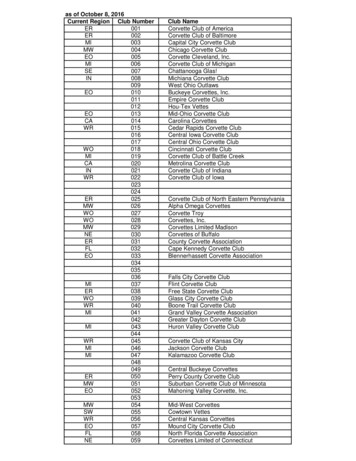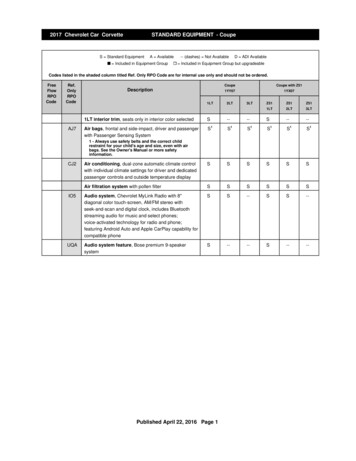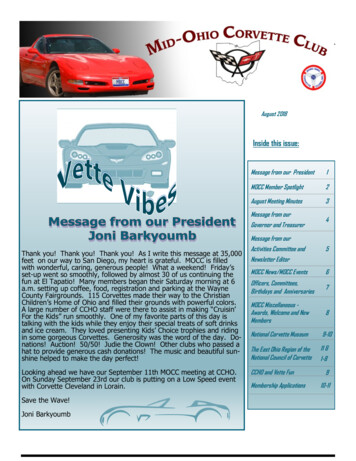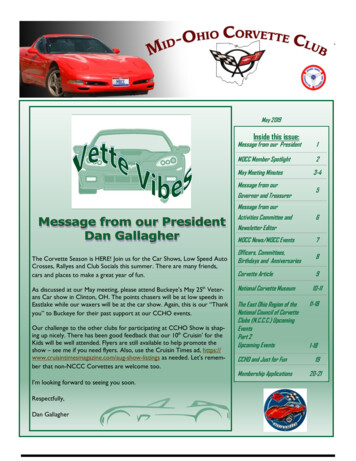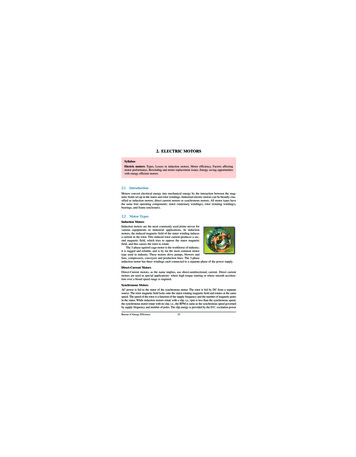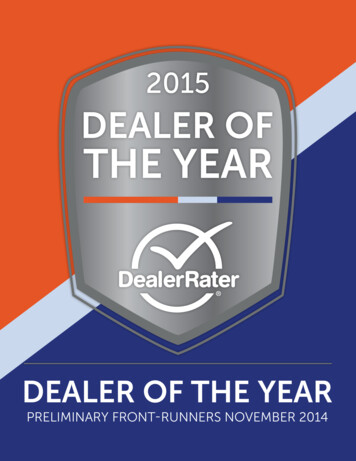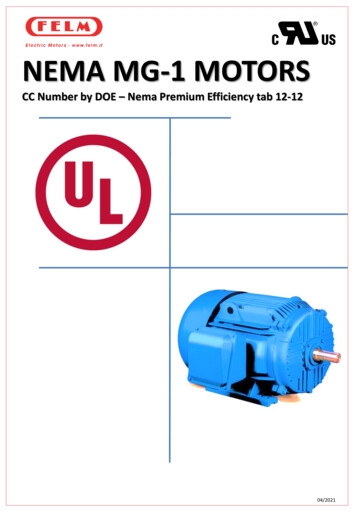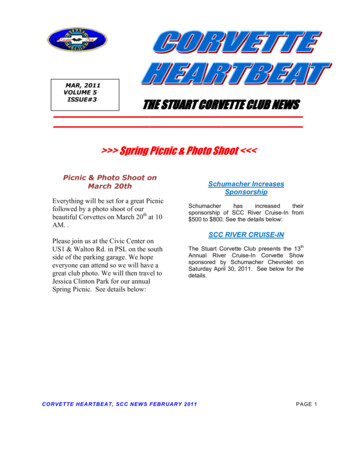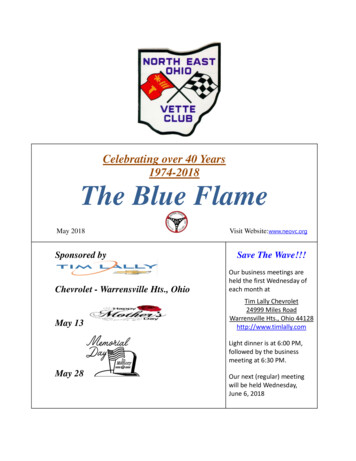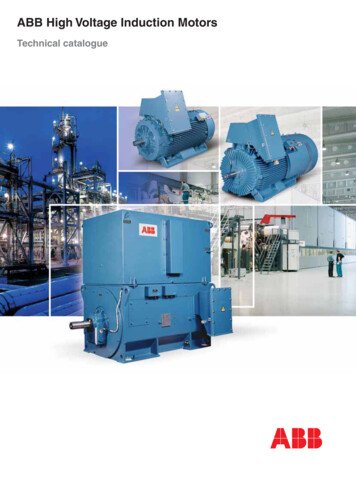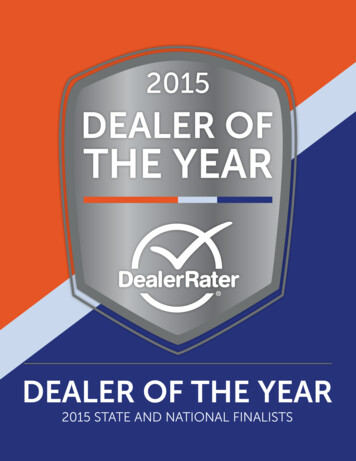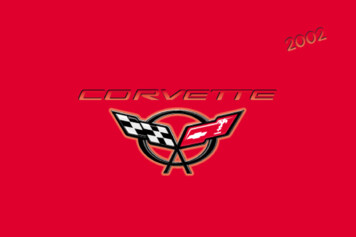
Transcription
2002 Chevrolet CorvetteOwner’s ManualLitho in U.S.A.Part Number 10444233 A First EditionECopyright General Motors Corporation 06/22/01All Rights Reservedi
We support voluntarytechnician certification.GENERAL MOTORS, GM, the GM Emblem,CHEVROLET, the CHEVROLET Emblem, thename CORVETTE and the CORVETTE Emblem areregistered trademarks of General Motors Corporation.This manual includes the latest information at the timeit was printed. We reserve the right to make changesafter that time without further notice. For vehicles firstsold in Canada, substitute the name “General Motorsof Canada Limited” for Chevrolet Motor Divisionwhenever it appears in this manual.Please keep this manual in your vehicle, so it willbe there if you ever need it when you’re on the road.If you sell the vehicle, please leave this manual in itso the new owner can use it.For Canadian Owners Who Prefer aFrench Language Manual:Aux propriétaires canadiens: Vous pouvez vousprocurer un exemplaire de ce guide en français chezvotre concessionaire ou au:Helm, IncorporatedP.O. Box 07130Detroit, MI 48207ii
Corvette: The AmericanDream MachineIn the early ’50s, it was only a designer’s dream.Today the Corvette stands alone as America’s dreamcar -- a testament to its unmistakable charisma andthe excitement it inspires. Unique styling, powerfulperformance and an undeniable panache have madeCorvette one of the most celebrated sports cars inthe world.In 1953, Corvette produced 300 new lightweightfiberglass roadsters. A handful went to project engineers,General Motors managers, and a select group of moviestars and celebrities. With a two-speed Powerglideautomatic transmission, Blue Flame six-cylinder engine,and gleaming Polo White exterior, the Corvette began itsdrive into the heart of America.Designers freshened up the ’Vette in 1956 by adding aremovable hardtop and the famous Corvette “coves.”The sculptured body enhanced its sporty look, and astandard 210-horsepower Chevy V8 engine solidifiedCorvette’s reputation as a production race car.iii
In 1963, Corvette hit the road with an eye-catching newlook -- the Sting Ray coupe. An instant success, thenow-classic Sting Ray featured concealed headlampsand a unique split rear window. The split window wouldonly be offered in 1963, making this model among themost prized Corvettes ever built.Restyled inside and out for 1968, this ’Vette sported alean and hungry shape, creating a sense of motion evenwhen standing still. And for the first time, Corvetteoffered removable roof panels.iv
For its 25th anniversary, the 1978 Corvette paced the 62nd Annual Indianapolis 500 and received a new fastbackroofline with a wide expanse of glass that wrapped around the sides.v
The structure of the fifth-generation redesign isthe stiffest ever developed in 44 years of Corvetteproduction, resulting in unparalleled ride quality andoutstanding handling. Also unique to the new Corvetteis a rear-mounted transmission.In 1984, the fourth generation of America’s favoritesports car anticipated the future with a sleek look andadvanced technology that provided superior handlingand performance. Windshield angle was the sheerest ofany domestic vehicle, cornering ability the tightest ofany production car. In short, the 1984 redesign enhancedthe Corvette’s reputation as a leader in the world sportscar market.After 44 years of production, Corvette only got better.The fifth-generation Corvette arrived in 1997, featuringa completely restyled body and a new, all-aluminum,5.7 Liter, 345-horsepower LS1 V8 engine.viAvailable as a Coupe for 1997, the new Corvetteoffered such standard features as extended-mobilitytires, a BoseR audio system, and a new, latch-operatedroof designed for easy removal.With many design cues inspired by the classic modelsof the 1960s, the new fifth-generation Corvette isan impressive combination of sleek styling andworld-class sports car performance. For 1998, inaddition to the Coupe, a convertible was reintroduced.The fifth-generation Corvette rollout was completed in1999 with the introduction of the hardtop model.For 2001, all hardtop models became the higherperformance Z06. The Z06 model featured theperformance enhanced LS6 engine, specific suspensioncomponents and exterior/interior differentiation.
Corvette Assembly PlantThe Corvette Assembly Plant in Bowling Green,Kentucky is one of the most sophisticated andcomputerized automobile assembly facilities inthe world. To build your 2002 Corvette, over1,025 employes teamed up with the 58 high-techrobots that assist in a variety of processes,from welding to painting.The Bowling Green facility is Corvette’s thirdhome since 1953. Since beginning production inJune of 1981, it has become one of Kentucky’smost popular tourist attractions.Corvette Assembly Plant tours are available.For dates and times, call (270) 745-8228.Reservations are required for groups of 10 or more.The new National Corvette Museum, located nearthe assembly plant, opened its doors in Septemberof 1994. It is also attracting tourists to the area.For more information, call 1-800-53-VETTE (83883)or (270) 781-7973.vii
How to Use this ManualMany people read their owner’s manual from beginningto end when they first receive their new vehicle. If youdo this, it will help you learn about the features andcontrols for your vehicle. In this manual, you’ll findthat pictures and words work together to explainthings quickly.CAUTION:These mean there is something that could hurtyou or other people.In the caution area, we tell you what the hazard is.Then we tell you what to do to help avoid or reducethe hazard. Please read these cautions. If you don’t,you or others could be hurt.Safety Warnings and SymbolsYou will find a number of safety cautions in this book.We use a box and the word CAUTION to tell youabout things that could hurt you if you were to ignorethe warning.viiiYou will also find a circlewith a slash through it inthis book. This safetysymbol means “Don’t,”“Don’t do this” or “Don’tlet this happen.”
Vehicle Damage WarningsVehicle SymbolsAlso, in this book you will find these notices:Your vehicle may be equipped with components andlabels that use symbols instead of text. Symbols,used on your vehicle, are shown along with the textdescribing the operation or information relating to aspecific component, control, message, gage or indicator.NOTICE:These mean there is something that could damageyour vehicle.If you need help figuring out a specific name of acomponent, gage or indicator reference the followingtopics in the Index:In the notice area, we tell you about something thatcan damage your vehicle. Many times, this damagewould not be covered by your warranty, and it couldbe costly. But the notice will tell you what to do to helpavoid the damage.DDDDWhen you read other manuals, you might seeCAUTION and NOTICE warnings in differentcolors or in different words.Also see “Warning Lights and Gages” in the Index.“Engine Compartment Overview”“Instrument Panel”“Comfort Controls”“Audio Systems”You’ll also see warning labels on your vehicle.They use the same words, CAUTION or NOTICE.ix
These are some examples of vehicle symbols you may find on your vehicle:x
Model ReferenceThis manual covers these models:Z06ConvertibleCoupexi
Section 1 Seats and Restraint SystemsHere you’ll find information about the seats in your vehicle and how to use your safety belts properly. You can alsolearn about some things you should not do with air bags and safety belts.1-21-71-111-121-131-191-20Seats and Seat ControlsSafety Belts: They’re for EveryoneHere Are Questions Many People AskAbout Safety Belts -- and the AnswersHow to Wear Safety Belts ProperlyDriver PositionSafety Belt Use During PregnancyPassenger Position1-201-261-291-321-421-451-451-45Air Bag SystemAir Bag Off SwitchChildrenRestraint Systems for ChildrenOlder ChildrenSafety Belt ExtenderChecking Your Restraint SystemsReplacing Restraint System PartsAfter a Crash1-1-1
Seats and Seat ControlsThis part tells you about the seats -- how to adjust them,and also about reclining seatbacks and seatback latches.Manual SeatsCAUTION:You can lose control of the vehicle if you try toadjust a manual driver’s seat while the vehicle ismoving. The sudden movement could startle andconfuse you, or make you push a pedal when youdon’t want to. Adjust the driver’s seat only whenthe vehicle is not moving.1-2To move a manual seat, pull up on the lever located infront of the seat to unlock it. Slide the seat to whereyou want it and release the lever. Then try to move theseat with your body to make sure the seat is lockedinto place.
Power Seats (Option)Different parts of the power seat control move differentparts of the seat. To move the seat forward or rearward,move the control in that direction. Move the control upto raise the seat and down to lower it. By tilting the backof the control, it will raise or lower the back of the seat.Tilting the front of the control will raise or lower thefront of the seat.Your preferred seat position can be stored and recalledif you have the memory option. See “Memory” inthe Index.If your vehicle has this option, the control for the powerseats will be located on the outboard side of each seat,near the base.1-3
Sport Seat (Option)Reclining SeatbacksIf your vehicle is equipped with a sport seat, there arethree other controls that help you change the shape of theseat in addition to the power seat control. There are twolumbar supports for the middle (A) and lower (B) back.There’s also a side bolster control (C) that adjusts the sidesof the seat around you to give you more lateral support.The lever for the reclining seatback is located on theoutboard side of each seat, near the base.For lumbar support, move each control (A and B)forward to inflate or rearward to deflate.Move the side bolster control (C) up for more sidesupport and down for less support.1-4To adjust the seatback, lean slightly forward to lift yourweight off the seatback. Pull completely up on the leveruntil it stops, and lean back to position the seatback towhere you want it. Release the lever to lock the seatbackinto place.
CAUTION:But don’t have a seatback reclined if your vehicleis moving.Sitting in a reclined position when your vehicle isin motion can be dangerous. Even if you buckleup, your safety belts can’t do their job whenyou’re reclined like this.The shoulder belt can’t do its job because itwon’t be against your body. Instead, it will bein front of you. In a crash you could go into it,receiving neck or other injuries.The lap belt can’t do its job either. In a crash thebelt could go up over your abdomen. The beltforces would be there, not at your pelvic bones.This could cause serious internal injuries.For proper protection when the vehicle is inmotion, have the seatback upright. Then sitwell back in the seat and wear your safetybelt properly.1-5
Seatback LatchesTo unlock, lift up on the latch and push the seatbackrearward. When you return the seatback to its originalposition, make sure the seatback is locked in place.CAUTION:If the seatback isn’t locked, it could move forwardin a sudden stop or crash. That could cause injuryto the person sitting there. Always press rearwardon the seatback to be sure it is locked.Both seatbacks fold forward to give you access tothe rear area. To fold a seatback forward, lift this latch,which is located on top of the backside of the seat, andpull the seatback forward. The seatback will lock downin this position.1-6
Safety Belts: They’re for EveryoneThis part of the manual tells you how to use safety beltsproperly. It also tells you some things you should not dowith safety belts.And it explains the air bag system.CAUTION:Don’t let anyone ride where he or she can’t weara safety belt properly. If you are in a crash andyou’re not wearing a safety belt, your injuriescan be much worse. You can hit things inside thevehicle or be ejected from it. You can be seriouslyinjured or killed. In the same crash, you mightnot be if you are buckled up. Always fasten yoursafety belt, and check that your passenger’s beltis fastened properly too.CAUTION:It is extremely dangerous to ride in a cargo area,inside or outside of a vehicle. In a collision,people riding in these areas are more likely to beseriously injured or killed. Do not allow peopleto ride in any area of your vehicle that is notequipped with seats and safety belts. Be sureeveryone in your vehicle is in a seat and using asafety belt properly.Your vehicle has a lightthat comes on as a reminderto buckle up. See “SafetyBelt Reminder Light” inthe Index.1-7
In most states and Canadian provinces, the law says towear safety belts. Here’s why: They work.Why Safety Belts WorkWhen you ride in or on anything, you go as fast as it goes.You never know if you’ll be in a crash. If you do havea crash, you don’t know if it will be a bad one.A few crashes are mild, and some crashes can be soserious that even buckled up a person wouldn’t survive.But most crashes are in between. In many of them,people who buckle up can survive and sometimes walkaway. Without belts they could have been badly hurtor killed.After more than 30 years of safety belts in vehicles,the facts are clear. In most crashes buckling up doesmatter . a lot!Take the simplest vehicle. Suppose it’s just a seat on wheels.1-8
Put someone on it.Get it up to speed. Then stop the vehicle. The riderdoesn’t stop.1-9
The person keeps going until stopped by something.In a real vehicle, it could be the windshield .1-10or the instrument panel .
Here Are Questions Many People AskAbout Safety Belts -- and the AnswersQ: Won’t I be trapped in the vehicle after anaccident if I’m wearing a safety belt?or the safety belts!With safety belts, you slow down as the vehicle does.You get more time to stop. You stop over more distance,and your strongest bones take the forces. That’s whysafety belts make such good sense.A:You could be -- whether you’re wearing a safetybelt or not. But you can unbuckle a safety belt,even if you’re upside down. And your chance ofbeing conscious during and after an accident, soyou can unbuckle and get out, is much greater ifyou are belted.Q:If my vehicle has air bags, why should I haveto wear safety belts?A:Air bags are in many vehicles today and willbe in most of them in the future. But they aresupplemental systems only; so they work withsafety belts -- not instead of them. Every air bagsystem ever offered for sale has required the use ofsafety belts. Even if you’re in a vehicle that has airbags, you still have to buckle up to get the mostprotection. That’s true not only in frontal collisions,but especially in side and other collisions.1-11
Q:If I’m a good driver, and I never drive far fromhome, why should I wear safety belts?A:You may be an excellent driver, but if you’re inan accident -- even one that isn’t your fault -- youand your passenger can be hurt. Being a gooddriver doesn’t protect you from things beyond yourcontrol, such as bad drivers.Most accidents occur within 25 miles (40 km)of home. And the greatest number of seriousinjuries and deaths occur at speeds of less than40 mph (65 km/h).Safety belts are for everyone.1-12How to Wear Safety Belts ProperlyAdultsThis part is only for people of adult size.Be aware that there are special things to know aboutsafety belts and children. And there are differentrules for smaller children and babies. If a child will beriding in your vehicle, see the part of this manual called“Children.” Follow those rules for everyone’s protection.First, you’ll want to know which restraint systems yourvehicle has.We’ll start with the driver position.
Driver PositionThis part describes the driver’s restraint system.Lap-Shoulder BeltThe driver has a lap-shoulder belt. Here’s how towear it properly.1. Close and lock the door.2. Adjust the seat so you can sit up straight.To see how, see “Seats” in the Index.3. Pick up the latch plate and pull the belt across you.Don’t let it get twisted.The lap-shoulder belt may lock if you pull the beltacross you very quickly. If this happens, let the beltgo back slightly to unlock it. Then pull the beltacross you more slowly.When the lap portion of the belt is pulled out all theway, it will lock. If it does, let it go back all the wayand start again. See “Lap Belt Cinch Feature” inthe Index.4. Push the latch plate into the buckle until it clicks.Pull up on the latch plate to make sure it is secure.If the belt isn’t long enough, see “Safety BeltExtender” at the end of this section.Make sure the release button on the buckle ispositioned so you would be able to unbuckle thesafety belt quickly if you ever had to.1-13
The lap part of the belt should be worn low and snugon the hips, just touching the thighs. In a crash, thisapplies force to the strong pelvic bones. And you’d beless likely to slide under the lap belt. If you slid under it,the belt would apply force at your abdomen. This couldcause serious or even fatal injuries. The shoulder beltshould go over the shoulder and across the chest.These parts of the body are best able to take beltrestraining forces.The safety belt locks if there’s a sudden stop or crash,or if you pull the belt very quickly out of the retractor.Lap Belt Cinch FeatureIf you do not want the lap belt to move freely, pull thelap belt out all the way to set the lock. To permit the lapbelt to move freely again, unbuckle the belt, let it retractall the way, and buckle up again.1-14
Q:What’s wrong with this?CAUTION:You can be seriously hurt if your shoulder belt istoo loose. In a crash, you would move forward toomuch, which could increase injury. The shoulderbelt should fit against your body.A:The shoulder belt is too loose. It won’t give nearlyas much protection this way.1-15
Q:What’s wrong with this?CAUTION:You can be seriously injured if your belt is buckledin the wrong place like this. In a crash, the beltwould go up over your abdomen. The belt forceswould be there, not at the pelvic bones. This couldcause serious internal injuries. Always buckle yourbelt into the buckle nearest you.A:The belt is buckled in the wrong place.1-16
Q:What’s wrong with this?CAUTION:You can be seriously injured if you wear theshoulder belt under your arm. In a crash, yourbody would move too far forward, which wouldincrease the chance of head and neck injury.Also, the belt would apply too much force to theribs, which aren’t as strong as shoulder bones.You could also severely injure internal organslike your liver or spleen.A:The shoulder belt is worn under the arm. It shouldbe worn over the shoulder at all times.1-17
Q:What’s wrong with this?CAUTION:You can be seriously injured by a twisted belt.In a crash, you wouldn’t have the full widthof the belt to spread impact forces. If a belt istwisted, make it straight so it can work properly,or ask your dealer to fix it.A:The belt is twisted across the body.1-18
Safety Belt Use During PregnancySafety belts work for everyone, including pregnantwomen. Like all occupants, they are more likely tobe seriously injured if they don’t wear safety belts.To unlatch the belt, just push the button on the buckle.The belt should go back out of the way.Before you close the door, be sure the belt is out of theway. If you slam the door on it, you can damage both thebelt and your vehicle.A pregnant woman should wear a lap-shoulder belt,and the lap portion should be worn as low as possible,below the rounding, throughout the pregnancy.1-19
The best way to protect the fetus is to protectthe mother. When a safety belt is worn properly,it’s more likely that the fetus won’t be hurt in a crash.For pregnant women, as for anyone, the key to makingsafety belts effective is wearing them properly.Passenger PositionThe passenger’s safety belt works the same way as thedriver’s safety belt. See “Driver Position” earlier inthis section.Air Bag SystemThis part explains the air bag system.Your vehicle has air bags -- one air bag for the driverand another air bag for the passenger.Frontal air bags are designed to help reduce the risk ofinjury from the force of an inflating air bag. But theseair bags must inflate very quickly to do their job andcomply with federal regulations.1-20Here are the most important things to know about theair bag system:CAUTION:You can be severely injured or killed in a crashif you aren’t wearing your safety belt -- even ifyou have air bags. Wearing your safety beltduring a crash helps reduce your chance ofhitting things inside the vehicle or beingejected from it. Air bags are designed to workwith safety belts, but don’t replace them.Air bags are designed to work only in moderateto severe crashes where the front of your vehiclehits something. They aren’t designed to inflateat all in rollover, rear or low-speed frontalcrashes, or in many side crashes. And, for someunrestrained occupants, air bags may provideless protection in frontal crashes than moreforceful air bags have provided in the past.Everyone in your vehicle should wear a safetybelt properly -- whether or not there’s an air bagfor that person.
CAUTION:Air bags inflate with great force, faster than theblink of an eye. If you’re too close to an inflatingair bag, as you would be if you were leaningforward, it could seriously injure you. Safety beltshelp keep you in position before and during acrash. Always wear your safety belt, even with airbags. The driver should sit as far back as possiblewhile still maintaining control of the vehicle.CAUTION:Anyone who is up against, or very close to, anyair bag when it inflates can be seriously injuredor killed. Air bags plus lap-shoulder belts offerthe best protection for adults, but not for youngCAUTION: (Continued)CAUTION: (Continued)children and infants. Neither the vehicle’s safetybelt system nor its air bag system is designedfor them. Young children and infants need theprotection that a child restraint system canprovide. Always secure children properly in yourvehicle. To read how, see the part of this manualcalled “Children.”There is an air bagreadiness light on theinstrument panel, whichshows the air bag symbol.The system checks the air bag electrical system formalfunctions. The light tells you if there is an electricalproblem. See “Air Bag Readiness Light” in the Indexfor more information.1-21
How the Air Bag System WorksThe passenger’s air bag is in the instrument panel on thepassenger’s side.Where are the air bags?The driver’s air bag is in the middle of the steering wheel.1-22
When should an air bag inflate?CAUTION:If something is between an occupant and anair bag, the bag might not inflate properly or itmight force the object into that person causingsevere injury or even death. The path of aninflating air bag must be kept clear. Don’t putanything between an occupant and an air bag, anddon’t attach or put anything on the steering wheelhub or on or near any other air bag covering.An air bag is designed to inflate in a moderate to severefrontal or near-frontal crash. The air bag will inflateonly if the impact speed is above the system’s designed“threshold level.” If your vehicle goes straight into awall that doesn’t move or deform, the threshold level isabout 9 to 15 mph (14 to 24 km/h). The threshold levelcan vary, however, with specific vehicle design, so thatit can be somewhat above or below this range. If yourvehicle strikes something that will move or deform,such as a parked car, the threshold level will be higher.The air bag is not designed to inflate in rollovers, rearimpacts, or in many side impacts because inflationwould not help the occupant.In any particular crash, no one can say whether an airbag should have inflated simply because of the damageto a vehicle or because of what the repair costs were.Inflation is determined by the angle of the impactand how quickly the vehicle slows down in frontal ornear-frontal impacts.1-23
What makes an air bag inflate?What will you see after an air bag inflates?In an impact of sufficient severity, the air bag sensingsystem detects that the vehicle is in a crash. The sensingsystem triggers a release of gas from the inflator,which inflates the air bag. The inflator, air bag andrelated hardware are all part of the air bag modulesinside the steering wheel and in the instrument panelin front of the passenger.After an air bag inflates, it quickly deflates, so quicklythat some people may not even realize the air baginflated. Some components of the air bag module -- thesteering wheel hub for the driver’s air bag, or theinstrument panel for the passenger’s bag -- will be hotfor a short time. The parts of the bag that come intocontact with you may be warm, but not too hot to touch.There will be some smoke and dust coming from ventsin the deflated air bags. Air bag inflation doesn’t preventthe driver from seeing or from being able to steer thevehicle, nor does it stop people from leaving the vehicle.How does an air bag restrain?In moderate to severe frontal or near-frontal collisions,even belted occupants can contact the steering wheel orthe instrument panel. Air bags supplement the protectionprovided by safety belts. Air bags distribute the forceof the impact more evenly over the occupant’s upperbody, stopping the occupant more gradually. But airbags would not help you in many types of collisions,including rollovers, rear impacts and many side impacts,primarily because an occupant’s motion is not towardthose air bags. Air bags should never be regarded asanything more than a supplement to safety belts,and then only in moderate to severe frontal ornear-frontal collisions.1-24CAUTION:When an air bag inflates, there is dust in the air.This dust could cause breathing problems forpeople with a history of asthma or other breathingtrouble. To avoid this, everyone in the vehicleshould get out as soon as it is safe to do so. If youhave breathing problems but can’t get out of thevehicle after an air bag inflates, then get fresh airby opening a window or door.
In many crashes severe enough to inflate an air bag,windshields are broken by vehicle deformation.Additional windshield breakage may also occurfrom the passenger air bag.D Let only qualified technicians work on your airbag system. Improper service can mean that yourair bag system won’t work properly. See your dealerfor service.D Air bags are designed to inflate only once. After theyinflate, you’ll need some new parts for your air bagsystem. If you don’t get them, the air bag systemwon’t be there to help protect you in another crash.A new system will include air bag modules andpossibly other parts. The service manual for yourvehicle covers the need to replace other parts.D Your vehicle is equipped with a diagnostic module,which records information about the air bag system.The module records information about the readinessof the system, when the system commands air baginflation and driver’s safety belt usage at deployment.The module also records speed, engine rpm, brakeand throttle data.NOTICE:If you damage the covering for the driver’s orthe passenger’s air bag, the bag may not workproperly. You may have to replace the air bagmodule in the steering wheel or both the airbag module and the instrument panel for thepassenger’s air bag. Do not open or break theair bag coverings.1-25
Air Bag Off SwitchYour vehicle has a switch in the glove box that you canuse to turn off the passenger’s air bag.Infant. An infant (less than 1 year old) must ride in thefront seat because:D my vehicle has no rear seat;D my vehicle has a rear seat too small to accommodatea rear-facing infant seat; orD the infant has a medical condition which, accordingto the infant’s physician, makes it necessary for theinfant to ride in the front seat so that the driver canconstantly monitor the child’s condition.Child age 1 to 12. A child age 1 to 12 must ride inthe front seat because:D my vehicle has no rear seat;D although children ages 1 to 12 ride in the rearseat(s) whenever possible, children ages 1 to 12sometimes must ride in the front because no spaceis available in the rear seat(s) of my vehicle; orD the child has a medical condition which, accordingThis switch should only be turned to AIR BAG OFFif the person in the passenger’s position is a memberof a passenger risk group identified by the nationalgovernment as follows:1-26to the child’s physician, makes it necessary for thechild to ride in the front seat so that the driver canconstantly monitor the child’s condition.
Medical Condition. A passenger has a medicalcondition which, according to his or her physician:D causes the passenger air bag to pose a special riskfor the passenger; andD makes the potential harm from the passenger air bagin a crash greater than the potential harm fromturning off the air bag and allowing the passenger,even if belted, to hit the dashboard or windshieldin a crash.CAUTION:If the passenger’s air bag is turned off for aperson who isn’t in a risk group identified bythe national government, that person won’t havethe extra protection of an air bag. In a crash,the air bag wouldn’t be able to inflate and helpprotect the person sitting there. Don’t turn offthe passenger’s air bag unless the person sittingthere is in a risk group.To turn off the passenger’s air bag, insert your ignitionkey into the switch, push in, and move the switch toAIR BAG OFF.1-27
The AIR BAG OFF light on the center console switchpanel will come on to let you know that the passenger’sair bag is off. The passenger’s air bag will remain offuntil you turn it back on again, and the AIR BAG OFFlight will stay on to remind you that the air bag is off.To turn the passenger’s air bag on again, insert yourignition key into the switch, push in, and move theswitch to the on position.1-28
Servicing Your Air Bag-Equipped VehicleChildrenAir bags affect how your vehicle should be serviced.There are parts of the air bag system in several places
sports car anticipated the future with a sleek look and advanced technology that provided superior handling and performance. Windshield angle was the sheerest of any domestic vehicle, cornering ability the tightest of any production car. In short, the 1984 redesign enhanced the Corvette's reputation as a leader in the world sports car market.
